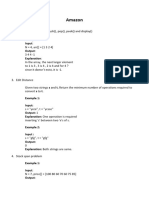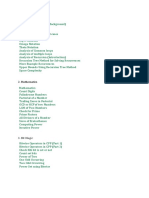Accenture Coding Round Cheatsheet - 1
Uploaded by
Saravana KohliAccenture Coding Round Cheatsheet - 1
Uploaded by
Saravana KohliAccenture coding round
Cheatsheet
Reverse a String: Write a function that reverses a given string.
Find the Maximum Element in an Array: Write a function that finds the
maximum element in a given array of integers.
Check if a String is a Palindrome: Write a function that checks if a given string
reads the same backward as forward.
Find the Missing Number in an Array: Given an array of consecutive integers
with one missing element, write a function to find the missing number.
Find the Intersection of Two Arrays: Write a function that finds the elements
present in both a given pair of arrays.
Remove Duplicates from an Array: Write a function that removes duplicate
elements from a given array while preserving the order.
Count the Occurrence of Each Element in an Array: Write a function that
counts the number of times each element appears in a given array.
Find the Second Largest Element in an Array: Write a function that finds the
second largest element in a given array.
Merge Two Sorted Arrays: Write a function that merges two sorted arrays into
a single sorted array.
Find the Length of the Longest Substring Without Repeating Characters:
Write a function that finds the length of the longest substring in a string where
all characters are unique.
Reverse a Linked List: Write a function that reverses a given linked list.
Implement a Stack Using an Array: Write code to implement a stack data
structure using an array.
Accenture coding round Cheatsheet 1
Implement a Queue Using an Array: Write code to implement a queue data
structure using an array.
Find the Lowest Common Ancestor in a Binary Tree: Write a function to find
the lowest common ancestor (LCA) of two given nodes in a binary tree.
Check if a Binary Tree is a Binary Search Tree (BST): Write a function that
checks if a given binary tree adheres to the properties of a BST.
Find the Level Order Traversal of a Binary Tree: Write a function that
performs a level-order traversal of a binary tree, returning the elements level
by level.
Clone a Linked List with Random Pointers: Write a function that creates a
deep copy of a linked list where each node also has a random pointer to
another node in the list.
Find the Kth Largest Element in an Array: Write a function that finds the kth
largest element in a given array.
Find All Combinations of a Sum: Write a function that finds all unique
combinations of numbers in a given array that add up to a specific target sum.
Binary Operations on Strings: Write a function that performs binary
operations like AND, OR, and XOR on a given string of binary numbers with
respective operators.
Calculate Binary Operations: Given a string with binary numbers and
operators (AND, OR, XOR), write a function to calculate the result by scanning
from left to right.
Find the Maximum and Its Index in an Array: Write a function to find the
greatest number in an array and its index.
Operation Choices: Write a function that performs operations (addition,
subtraction, multiplication, division) based on a given integer parameter.
Food Distribution Among Rats: Given the number of rats and their food
requirement, write a function to determine if the food available in different
houses is sufficient.
You are given a function, intMaxExponents(int a, int b) Find and return the
number between ‘a’ and ‘b'(range inclusive on both ends) which has the
Accenture coding round Cheatsheet 2
maximum exponent of 2.
Execute this function of Accenture Coding Questions: def
differenceofSum(n.m)
Example: If Input is m = 6, n = 30, then output will be 285. Integers divisible by
6 are 6, 12, 18, 24, and 30. Their sum is 90.
Form an array of 1000 integers and find out the second-largest number. If
there is no second-largest number, return the value to –1.
Adam decides to do some charity work. From day 1 till day x, he will give i^2
coins to charity. On the day ‘i’ (1 < = i < = x), find the number of coins he
gives to charity.
Find the sum of the divisors for the N integer number.
Write a program that accepts the integer array of length ‘size’ and finds the
largest number that can be formed by permutation.
Write a function SmallLargeSum(array) which accepts the array as an
argument or parameter, that performs the addition of the second largest
element from the even location with the second largest element from an odd
location?
Rules
a. All the array elements are unique.
b. If the length of the array is 3 or less than 3, then return 0.
c. If Array is empty then return zero.
Sample Test Case 1:
Input:
6
321754
Output:
7
Explanation: The second largest element in the even locations (3, 1, 5) is 3.
The second largest element in the odd locations (2, 7, 4) is 4. So the addition
Accenture coding round Cheatsheet 3
of 3 and 4 is 7. So the answer is 7.
Write a function CheckPassword(str) which will accept the string as an
argument or parameter and validates the password. It will return 1 if the
conditions are satisfied else it’ll return 0?
The password is valid if it satisfies the below conditions:
a. It should contain at least 4 characters.
b. At least 1 numeric digit should be present.
c. At least 1 Capital letter should be there.
d. Passwords should not contain space or slash(/).
e. The starting character should not be a number.
Sample Test Case:
Input:
bB1_89
Output:
Approach:
1. Using if condition check whether the length of string is greater than equal
to 4 or not.
2. Run a loop on the string and check if any character is a digit or not. It is a
digit if it’s between ‘0’ and ‘9’.
3. Iterate the string and check that only at least one letter should be between
‘A’ and ‘Z’, i.e it should be capital.
4. Run a loop on string and check no character should match space(‘ ‘) or
slash (‘/’).
5. Check that the first character should not lie between ‘0’ and ‘9’.
Write a function FindMaxInArray, which will find the greatest number from
an array with its desired index? The greatest number and its desired index
should be printed in separate lines.
Accenture coding round Cheatsheet 4
Sample Test Case:
Input:
10
15 78 96 17 20 65 14 36 18 20
Output:
96
Write a function OperationChoices(c, a, b) which will accept three integers
as an argument, and the function will return:
a. (a + b) if the value of c=1.
b. (a – b) if the value of c=2.
c. (a b) if the value of c=3.
d. (a / b) if the value of c=4.
Sample Test Case:
Input:
15
20
Output:
You are required to input the size of the matrix then the elements of matrix,
then you have to divide the main matrix in two sub matrices (even and odd)
in such a way that element at 0 index will be considered as even and
element at 1st index will be considered as odd and so on. Then you have sort
the even and odd matrices in ascending order and print the sum of second
largest number from both the matrices.
Execute the given function.
def differenceofSum(n.m)
Accenture coding round Cheatsheet 5
The function takes two integrals m and n as arguments. You are required
to obtain the total of all integers ranging between 1 to n (both inclusive)
which are not divisible by m. You must also return the distinction between
the sum of integers not divisible by m with the sum of integers divisible by
m.
Assumption
m > 0 and n > 0
Sum lies within the integral range
Sample input:
m=3
n = 10
Sample output:
19
Execute the given function.
def LargeSmallSum(arr)
The function takes an integral arr which is of the size or length of its
arguments. Return the sum of the second smallest element at odd position
‘arr’ and the second largest element at the even position.
Assumption
Every array element is unique.
Array is 0 indexed.
Example
Input:
Arr: 3 2 1 7 5 4
Output:
Explanation
The second largest element at the even position is 3.
The second smallest element at the odd position is 4.
Accenture coding round Cheatsheet 6
The output is 7 (3 + 4).
Write a function to validate if the provided two strings are anagrams or not.
If the two strings are anagrams, then return ‘yes’. Otherwise, return ‘no’.
Example
Input 1: Listen
Input 2: Silent
Output:
Yes
Explanation
Listen and Silent are anagrams (an anagram is a word formed by rearranging
the letters of the other word).
The given function has a string (str) and two characters, ch1 and ch2.
Execute the function in such a way that str returns to its original string, and
all the events in ch1 are replaced by ch2, and vice versa.
Replacecharacter(Char str1, Char ch1, Int 1, Char ch2)
Example
Input:
str: apples
ch1: a
ch2: p
Output:
paales
Explanation
All the ‘a’ in the string is replaced with ‘p’. And all the ‘p’s are replaced with ‘a’.
Write a function to find roots of a quadratic equation ax^2 + bx + c = 0.
Find the sum of the divisors for the N integer number.
Perform a function to reverse a string word-wise. The input here will be the
string. In the output, the last word mentioned should come as the first word
and vice versa
Accenture coding round Cheatsheet 7
Write a program to count the number of swaps required to sort a given list of
integers in ascending order using the selection sort algorithm.
The function accepts an integer array ‘arr’ of size ‘n’ as its argument. Each
element of ‘arr’ represents the number of chocolates distributed to a person.
The function needs to return the minimum number of chocolates that need to
be distributed to each person so that the difference between the chocolates of
any two people is minimized.
Example:
Input: Output:
n: 5 3
arr: 10 4 12 3 1
The function accepts a character array ‘arr’ of size ‘n’ as its argument. Each
element of ‘arr’ represents the status of a parking slot, where ‘S’ represents an
empty slot and ‘X’ represents an occupied slot. The function needs to return
the maximum number of cars that can be parked in the parking lot. It is
assumed that two cars cannot occupy the same slot and cars can only park in
consecutive empty slots.
The function accepts a string ‘str’ as its argument. The function needs to
return the transformed string by replacing all occurrences of the character ‘a’
with the character ‘b’ and vice versa.
Input: Output:
str: abaabbcc bbbbaaac
The function accepts an integer array ‘arr’ of size ‘n’ as its argument. The
function needs to return the index of an equilibrium point in the array, where
the sum of elements on the left of the index is equal to the sum of elements on
the right of the index. If no equilibrium point exists, the function should return
-1.
Input: Output:
n: 5 3
arr: 1 3 5 7 3
Accenture coding round Cheatsheet 8
The function accepts an integer array ‘arr’ of size ‘n’ and an integer ‘d’ as its
argument. The function needs to rotate the array ‘arr’ by ‘d’ positions to the
right. The rotation should be done in place, without using any additional
memory.
Input: Output:
n: 5 34512
arr: 1 2 3 4 5
d: 3
The function accepts two strings ‘str1’ and ‘str2’ as its argument. The function
needs to return the index of the first occurrence of substring ‘str2’ in string
‘str1’ or -1 if the substring is not found.
Input: Output:
str1: “Hello, World!” 7
str2: “World”
The function accepts a string ‘str’ as its argument. The function needs to
reverse the order of the words in the string.
Example:
Input: Output:
str: “Hello, World!” !dlroW ,olleH
Given an array of integers and an integer sum, find a pair of numbers (a, b) in
the array where a + b = sum.
Input: Output:
An array of two integers
An array of
representing the pair (a, b) or -1
integers
if no such pair exists
An integer sum
Given an array of integers, find the maximum subarray sum. A subarray is a
contiguous subsequence of the array.
Accenture coding round Cheatsheet 9
Given a string str, a character ch1, and a character ch2, replace all
occurrences of ch1 in str with ch2 and vice versa.
Input: Output:
str = “apples”, ch1 = ‘a’, ch2 = ‘p’ str = “paales”
Given an integer array, find the minimum value and its index in the array.
Example:
Input: Output:
[5, 2, 4, 1, 3] 13
Given an array of integers, find the average of all positive numbers in the
array.
Input: Output:
[5, 2, -4, 1, 3] 3
Given an integer array and an integer element, count the number of
occurrences of the element in the array.
Example:
Input: Output:
[5, 2, 4, 1, 2], 2 2
Given an integer array and an integer element, check if the array contains the
element.
Input: Output:
[5, 2, 4, 1, 3], 2 True
Accenture coding round Cheatsheet 10
You might also like
- Accenture Coding Questions With Answers: Q1. Binary String Operations25% (4)Accenture Coding Questions With Answers: Q1. Binary String Operations11 pages
- TF Accenture Coding Preparatory MaterialNo ratings yetTF Accenture Coding Preparatory Material42 pages
- Accenture Coding Questions and Solution 20240% (1)Accenture Coding Questions and Solution 202418 pages
- Accenture Coding previous year questionsNo ratings yetAccenture Coding previous year questions21 pages
- InterviewCodingQuestions Ecommerce ArrayNo ratings yetInterviewCodingQuestions Ecommerce Array15 pages
- DAA LAB - Fast Learner's - Problem - 22CSH - ITH-311No ratings yetDAA LAB - Fast Learner's - Problem - 22CSH - ITH-3118 pages
- Coding Questions (Accenture and Cognizant)No ratings yetCoding Questions (Accenture and Cognizant)30 pages
- Accenture Coding Set B Sol - 6748548 - 2024 - 09 - 25 - 21 - 03No ratings yetAccenture Coding Set B Sol - 6748548 - 2024 - 09 - 25 - 21 - 0320 pages
- Codegoda 2022,23 Problems With SolutionsNo ratings yetCodegoda 2022,23 Problems With Solutions42 pages
- Programming Fundamentals (CS 1002) Fall 2021 Assignment # 2: Due DateNo ratings yetProgramming Fundamentals (CS 1002) Fall 2021 Assignment # 2: Due Date8 pages
- Accenture 2025 Shift Coding Sheet WatermarkNo ratings yetAccenture 2025 Shift Coding Sheet Watermark9 pages
- Assignment 2 Topic: Searching/Sorting: Input FormatNo ratings yetAssignment 2 Topic: Searching/Sorting: Input Format10 pages
- Essential_Coding_Questions_Basic_to_AdvancedNo ratings yetEssential_Coding_Questions_Basic_to_Advanced9 pages
- In Memory Pointer Chasing Accelerator - Iccd16No ratings yetIn Memory Pointer Chasing Accelerator - Iccd168 pages
- Cembrano, Stephanie Rei Allana S. DICT 2-1 Quiz 1No ratings yetCembrano, Stephanie Rei Allana S. DICT 2-1 Quiz 14 pages
- 200 LATEST JAVA 2 Marks Questions and Answers p222222260% (5)200 LATEST JAVA 2 Marks Questions and Answers p22222221 page
- B.B.A ( C.A ) Sem 3rd and 4th Paper setNo ratings yetB.B.A ( C.A ) Sem 3rd and 4th Paper set26 pages
- Intermediate Object-Oriented Programming: Practice Class 09 (Week 10)No ratings yetIntermediate Object-Oriented Programming: Practice Class 09 (Week 10)3 pages
- DSA by Shradha Didi & Aman Bhaiya - DSA in 2.5 MonthsNo ratings yetDSA by Shradha Didi & Aman Bhaiya - DSA in 2.5 Months5 pages
- Accenture Coding Questions With Answers: Q1. Binary String OperationsAccenture Coding Questions With Answers: Q1. Binary String Operations
- DAA LAB - Fast Learner's - Problem - 22CSH - ITH-311DAA LAB - Fast Learner's - Problem - 22CSH - ITH-311
- Accenture Coding Set B Sol - 6748548 - 2024 - 09 - 25 - 21 - 03Accenture Coding Set B Sol - 6748548 - 2024 - 09 - 25 - 21 - 03
- Programming Fundamentals (CS 1002) Fall 2021 Assignment # 2: Due DateProgramming Fundamentals (CS 1002) Fall 2021 Assignment # 2: Due Date
- Assignment 2 Topic: Searching/Sorting: Input FormatAssignment 2 Topic: Searching/Sorting: Input Format
- 200 LATEST JAVA 2 Marks Questions and Answers p2222222200 LATEST JAVA 2 Marks Questions and Answers p2222222
- Intermediate Object-Oriented Programming: Practice Class 09 (Week 10)Intermediate Object-Oriented Programming: Practice Class 09 (Week 10)
- DSA by Shradha Didi & Aman Bhaiya - DSA in 2.5 MonthsDSA by Shradha Didi & Aman Bhaiya - DSA in 2.5 Months





























































































